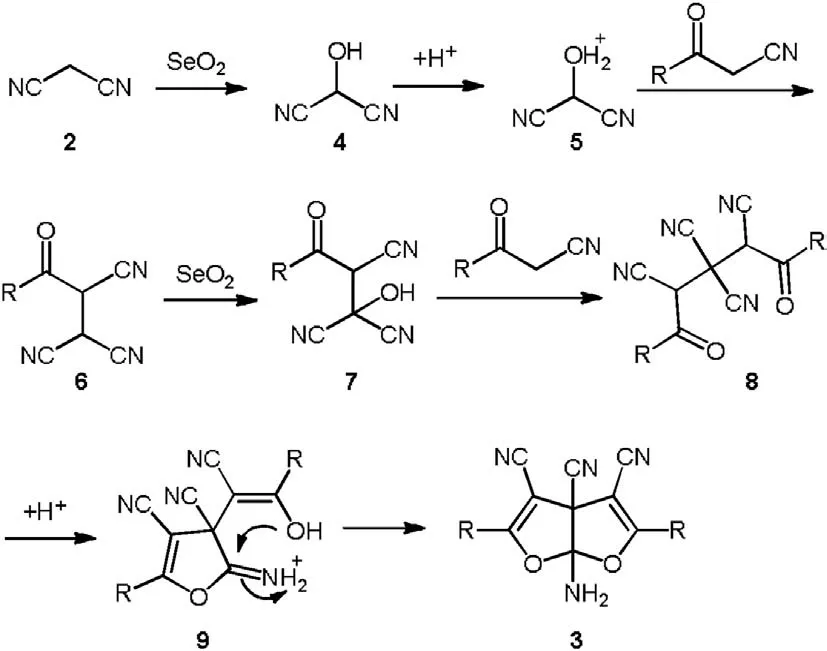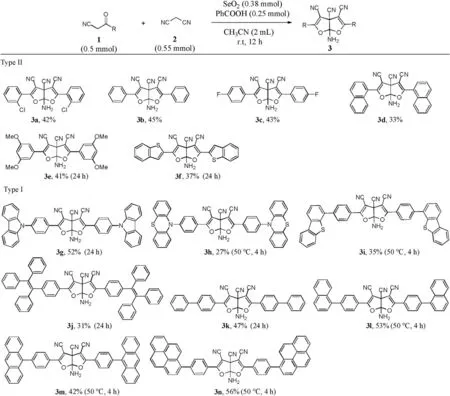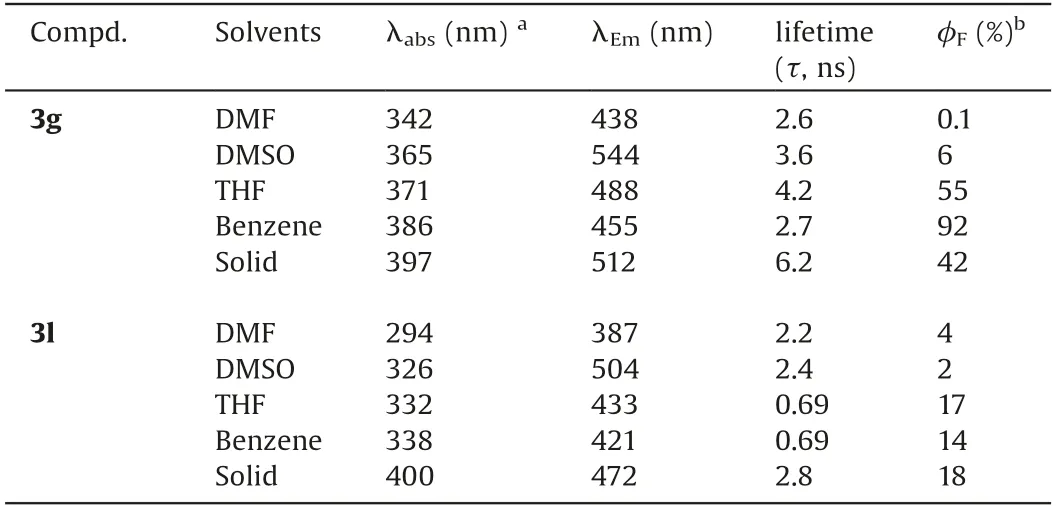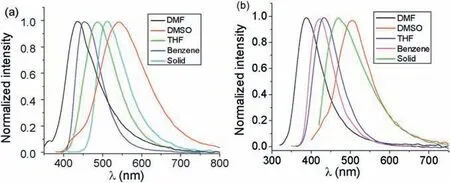One-pot synthesis of dual-state emission(DSE)luminogens containing the V-shape furo[2,3-b]furan scaffold
2021-04-02JieZhouMannaHuangXinhaiZhuYiqianWan
Jie Zhou,Manna Huang*,Xinhai Zhu,Yiqian Wan*
a School of Chemical Engineering and Technology, Guangdong Engineering Technology Research Center for Platform Chemicals from Marine Biomass and Their Functionalization, Sun Yat-sen University, Zhuhai 519082, China
bInstrument Analysis & Research Center, Sun Yat-sen University, Guangzhou 510275, China
ABSTRACT To discover novel fluorophores of solution and solid dual-state emission(DSE)materials,unique V-shape furo[2,3-b]furans have been designed and synthesized by a one-pot method for the first time and their photoluminescent properties have been explored in benzene,THF,DMF and DMSO,as well as in the solid state.As the best example, 2,5-bis(4-(9H-carbazol-9-yl)phenyl)-6a-amino-3a,6a-dihydrofuro[2,3-b]furan-3,3a,4-tricarbonitrile(3g)exhibited solution and solid DSE properties in THF,benzene,and in the solid state with quantum yields of 55%, 92%, and 45%, respectively.
Keywords:One-pot synthesis Furo[2,3-b]furan Selenium dioxide V-Shape Dual-state emission
Conventional organic fluorophores generally exhibit highly efficient luminescence in dilute solution owing to the presence of planar polycyclic π-conjugated frameworks and have gained extensive applications in relatively dilute solution [1].However,their aggregation-caused quenching(ACQ)is often detrimental to practical applications in the solid state,such as in the fabrication of organic light-emitting diodes (OLED) [2], optical devices [3] and organic luminescent displays[3a,4].In contrast to this effect,Tang and co-workers observed and conceptually coined aggregationinduced emission (AIE) at the turn of the century [5].Since then,numerous organic AIEgens have been developed through restricting intramolecular motion, and they have been used in a wide range of applications including chemo/ biosensors [6] and bioimaging [7], OLEDs [2b], solar cells [8], and optical devices[9], and others [10].
It should be noted that there remains a significant gap between ACQ and AIE photoluminogens[11].Developing photoluminogens that are highly efficient both in solution and in the solid state(i.e.,dual-state emission,DSE),is therefore important in order to bridge the gap so that both meet the fabrication requirements of various functional materials,as well as to provide additional materials for deeper exploration of the differences of photoluminescence in different types of solvents [11,12].As a result, several typical solution and solid DSE luminogens have recently been developed;however, solution and solid DSE luminogens that are active in all types of solvents (all-powerful solution and solid DSE molecules)are rare[13].In contrast,solution and solid DSE molecules that are active only in the solid state,or in particular single solvents such as THF [14], dichloromethane [12,15], chloroform [16] and other particular types of solvents, have been developed [13a-c,17].
The furo[2,3-b]furan structure, a fused cyclic acetal, exists in several biologically active natural products and pharmaceuticals[18].However,the parent furo[2,3-b]furan system and substituted derivatives are not widely known as luminogens.It was easy to determine that the donor-acceptor-donor (D-A-D) V-shape scaffold [19] in 4-tricyanofuro-[2,3-b]furans would enhance the intramolecular charge transfer (ICT) between donor and acceptor moieties.In addition, considering the other reported types of V-shape photoluminescence potentially removes the tendency of short-range π-π intermolecular interactions that lead to quenching of the fluorescence [20], and we assumed that compounds containing the unique V-shape furo[2,3-b]furan scaffold would exhibit luminescence both in solution and in the solid state.
To develop alternative methods for synthesis of the furo[2,3-b]furan core and to search for novel solution and solid DSE luminophores, we report the design and synthesis of novel solution and solid DSE luminogens based on the V-shape furo[2,3-b]furan scaffold.
In the only reported synthetic method [19] for preparation of 6a-amino-2,5-diaryl-furo[2,3-b]furan-3,3a,4(6aH)-tricarbonitrile,2-bromomalononitrile is reacted with various 2-cyanoacetophenones to afford the target compounds in moderate yields.Considering the cost and the commercial availability of 2-bromomalononitriles,we tried more readily available malononitriles instead of 2-bromomalononitriles to develop a novel preparative method.As shown in Scheme 1, SeO2was assumed to oxidize malononitrile to 2-hydroxy-malononitrile, which can then react with 3-oxo-3-arylpropane-nitriles to provide the target compounds.
Initially, the desired product 3a was obtained from 2-chlorobenzoylacetonitrile (1a) (0.5 mmol) by reacting with malononitrile(2)in isolated yield of 10%by means of oxidation of 1.1 equiv.of SeO2in CH3CN in the presence of 1.1 equiv.of NH4H2PO4at room temperature for 12 h(Table 1,entry 1).Further optimization of the main reaction conditions,including additives,solvents and ratio of starting materials (Table 1), gave rise to a novel one-pot protocol for the synthesis of 6a-amino-2,5-diaryl-furo[2,3-b]furan-3,3a,4(6aH)-tricarbonitriles: namely, 0.5 mmol of 1a was treated with 1.1equiv.of2and0.75equiv.ofSeO2inCH3CN(2 mL)inthepresence of 0.5 equiv.of benzoic acid at room temperature for 12 h(Table 1,entry16).

Scheme 1.Plausible mechanism of the novel protocol.

Table 1 Optimization of the model reaction.a
Based on the effective protocol, we designed two series of 6aamino-2,5-diaryl-furo[2,3-b]furan3,3a,4(6aH)tricarbonitriles(with and without a phenyl group spacer).It should be noted that the phenyl group spacer was envisioned to allow the possibility of extending the conjugation and increasing intermolecular π-π interaction, thus leading to restriction of intramolecular rotation,which would result in effective photoluminescence.The target compounds were obtained although the isolated yields were moderate (Scheme 2) because of the expected side reaction of trimerization of acetonitriles(compound 1)as reported previously[21].
The photoluminescence properties of the compounds were then explored, both in solution and in the solid state, to gain further mechanistic insight into whether the V-shape scaffold helps to avoid the short-range π-π intermolecular interactions that lead to fluorescence quenching [20a].As shown in Table S1(Supporting information), type I compounds with phenyl spacer(3k, 3l) exhibited better photoluminescence (PL) efficiency than their counterparts without a phenyl spacer(type II compounds 3b and 3d).We then focused on the type I compounds to investigate the AIE/ACQ properties.The results (Fig.S6 in Supporting information) of classic ACQ/AIE distinctive experiments (i.e.,determination of PL spectra in H2O/THF mixture with different water contents)[22]indicated that 3i,3m,and 3n exhibited clear ACQ phenomena; meanwhile, 3h, 3j, and 3k, exhibited AIE phenomena.Interestingly, as shown in Table 2 and Fig.1, 3g and 3l exhibited the desired solution and solid DSE properties in THF, benzene, and in the solid state with PL efficiencies of 55%,92%, 45% and 17%, 14%, 18%, respectively, although they showed reduced solution and solid DSE PL efficiency in DMF(0.1%and 4%,respectively) and DMSO (6% and 2%, respectively).The relatively high fluorescence quantum yield of carbazole is thought to result from the nonbonding orbital overlap of the adjacent carbon atoms on the carbazole ring,while the enhanced basicity of the molecule in the excited state interacts with more acidic DMF, possible affording a great non-radiative and a leading to diminished PL efficiency.The most polar solvent,DMSO,reduced the energy level of the excited states,reducing the difference between the ground and excited states,which could be the main reason for the largest Stokes shift values of 179 nm and 178 nm, respectively.
To further understand the difference in PL efficiency between type I and type II compounds in the solid state,we investigated the molecular interaction in the solid state by single crystal X-ray diffraction.Representative 3d and 3g (type II and type I,respectively) were explored owing to their PL performance in the solid state.As shown in Fig.2,intermolecular π-π interactions between two naphthalene-1-yl rings or between two carbazolyl rings,along with the intermolecular H-bonding between V-shape moieties, resulted in J-aggregate packing leading to restricted rotation of the aromatic rings.Most probably, the stronger intermolecular π-π interactions observed in 3d at least resulted in more non-radiative relaxation,owing to the increased planarity of the naphthalene ring in comparison with the low planarity of the carbazole ring in 3g.As a result, 3g displayed better PL efficiency in the solid state than 3d.

Scheme 2.Scope of the 3-oxo-3-arylpropanenitriles.

Table 2 Optical properties of the compounds.

Fig.1.Normalized PL emission spectra of compounds 3g(a)and 3l(b)in different solvents(2×10-5 mol/L)and in the solid state.Excited by the longest wavelength absorption maximum.The solid is amorphous.
In conclusion, we established a novel one-pot protocol for the preparation of V-shape furo[2,3-b]furan molecules.Two series of 6a-amino-2,5-diaryl-furo[2,3-b]furan-3,3a,4(6aH)-tricarbonitrile photoluminogens(with and without a phenyl group spacer)were designed and synthesized. Both provided interesting photoluminescence properties both in examined solution and in the solid state.Compound 3g, as the best example, exhibited the desired solution and solid DSE properties in THF, benzene, and in the solid state with PL efficiencies of 55%, 92%, and 45%,respectively.Mechanistic investigation by single crystal X-ray diffraction analysis demonstrated that the high PL efficiency primarily resulted from the restriction of intramolecular rotation.

Fig.2.Molecular interactions in single crystal 3d and 3g.
Declaration of competing interest
The authors declare that they have no known competing financial interests or personal relationships that could have appeared to influence the work reported in this paper.
Acknowledgments
This work was supported by grants from the National Natural Science Foundation of China (No.21702239), Guangzhou Science and Technology Plan Projects(No.201707010271),the Fundamental Research Funds for the Central Universities (No.16lgpy16).
Appendix A.Supplementary data
Supplementary material related to this article can be found,in the online version,at doi:https://doi.org/10.1016/j.cclet.2020.02.038.
杂志排行
Chinese Chemical Letters的其它文章
- A biomass based photonic crystal made of “konjac tofu”
- Hydrothermal-assisted grinding route for WS2 quantum dots (QDs)from nanosheets with preferable tribological performance
- Superiority of poly(L-lactic acid) microspheres as dermal fillers
- Zwitterionic comb-like lipid polymers encapsulating linalool for increasing the fragrance retention time
- Construction of a nano-rectangular Zn-Nd complex with near-infrared luminescent response towards metal ions
- Synthesis and structure of Au19Ag4(S-Adm)15 nanocluster:Polymorphs and optical properties
